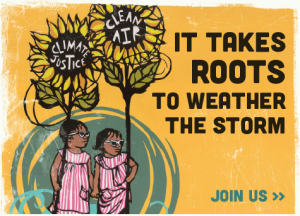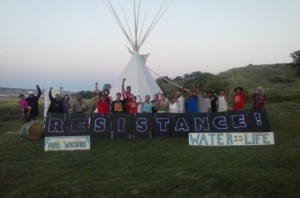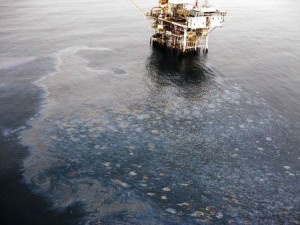Indigenous Peoples at Forefront of Historic People’s Climate March in New York City
With climate change a no-brainer in the credible scientific world, and more and more people—indigenous and non-Native alike—experiencing firsthand its effects on the ground, United Nations Secretary General Ban Ki-moon has summoned world leaders for a one-day summit to work toward an agreement on reducing greenhouse gas emissions.
Just in case they are not listening, the people will follow suit. The weekend before the U.N. summit, the rank-and-file are descending upon New York City to demand action in the People’s Climate March, to be held on Sunday, September 21. Foremost among them will be Native activists from across Turtle Island and beyond, standing side-by-side with environmentalists and others interested in keeping Mother Earth habitable. According to some of the activists on the ground, the climate march is shaping up to be the largest yet.
“The climate rally in Washington D.C. in February 2012 had approximately 35,000 people in attendance,” said Canadian aboriginal organizer Crystal Lameman (Beaver Lake Cree Nation, Treaty No.6), Climate and Energy Campaigner and Tar Sands Coordinator with the Sierra Club of Canada, and formerly of the Indigenous Environmental Network. “We are expecting about double that this time. My understanding is that this is being coined as the continuation of the ‘Forward on Climate’ Rally [as the 2012 march was known]… and that there is a large delegation of indigenous folks coming from all over Turtle Island and actually on a global level.”
In keeping with the trend of recent years, Indigenous Peoples are taking a lead role in the organization of the non-governmental civil society events. One of the featured speakers, for example, will be Erica Violet Lee, a student and activist associated with the Idle No More movement. And the International Indian Treaty Council is one of the organizing partners of the People’s Climate March.
The United Nations Headquarters will be center stage for General Assembly-level meetings that include the World Conference on Indigenous Peoples (WCIP) on September 22-23, now four years in the planning. September 23 will also see a one-day meeting titled “U.N. Climate Summit—Catalyzing Action,” which will be a gathering of heads of state, civil society and private sector representatives to discuss ambitious new plans to curb greenhouse gases.
In addition to the Climate Summit there will be an alternative conference organized by a variety of environmental and human rights organizations, culminating in the September 21 march. The conference, the “NYC Climate Convergence,” will be held from September 19-21 in advance of the U.N. summit. It will feature some of the most prominent environmental activists of our time, including Naomi Klein, Vandana Shiva, Christian Parenti, and Patrick Bond. Billed as “a conference, skill share, and festival rolled into one,” it will cover a diversity of topics all related to climate change, discussing everything from ending the use of fossil fuels and nuclear energy, to the creation of living-wage jobs.
In July the U.N. Climate Summit organizing committee, the U.N. Secretary-General’s Climate Change Support Team, issued a call for civil society participation through a nomination process. The committee received an enthusiastic 544 nominations for approximately 30 seats. As of this writing the list had been pared down to 76 candidates. North American Indigenous Peoples on that short list include actress Irene Bedard (Inupiaq/Yupik /Cree), Margaret Hiza (Crow) from the Indian Nations Conservation Alliance and Melissa Ann Daniels (Athabasca Chipewyan) from the Native Women’s Association of Canada.
Besides being a watershed moment for indigenous voices in the environmental movement, the grassroots activities also reflect the broad participation of indigenous women in the climate movement, Lameman noted.
“The indigenous people along with the women are going to be leading the march,” she told ICTMN. “It sets the stage for how we’re moving forward as the indigenous people and women are starting to take these spaces now. As a young indigenous woman raised in indigenous politics, it really is something.”
Lameman’s family is no stranger to the frontline struggles of indigenous peoples battling resource extraction in their homelands. Her Beaver Lake Cree community is sandwiched between two of the three tar sands deposits in Alberta, Canada.
“My nation is one of the nations involved in a very high profile litigation against the federal government of Canada, the provincial government of Alberta and the British Crown in relation to the resource development in our traditional hunting territory,” Lameman said. “It’s the reason I do the work I do.”
Despite gains for Native voices and recognition of traditional knowledge within the environmental movement, the cacophony of events regarding climate change could drown out some of those very voices in the World Conference on Indigenous Peoples, Lameman allowed.
“I feel conflicted about it,” Lameman said. “I feel that indigenous peoples have not been given the space they deserve. I also feel that there has been this division created between things like discussions on climate and Mother Earth and the rights of Mother Earth, and indigenous peoples and human rights. In reality they are all interconnected, and there should be no division or higher soapbox. The problem with these policies is that they were created with division in mind. It’s the reason I have decided against attending any of the U.N. negotiations.”
Read more at http://indiancountrytodaymedianetwork.com/2014/09/04/indigenous-peoples-forefront-historic-peoples-climate-march-new-york-city-156743





